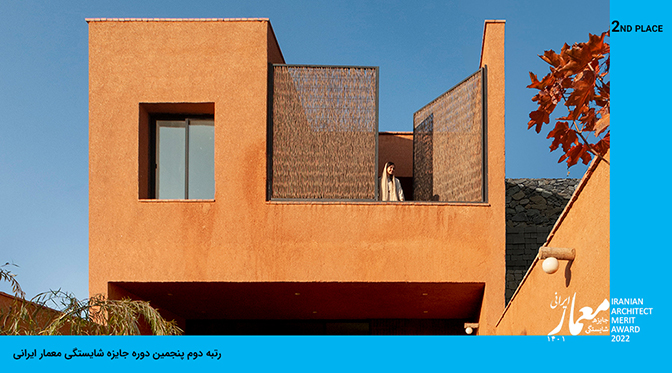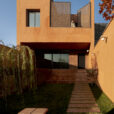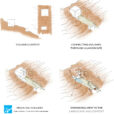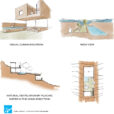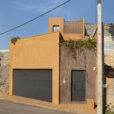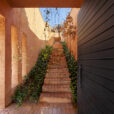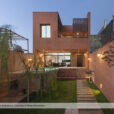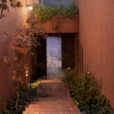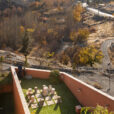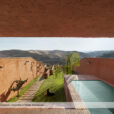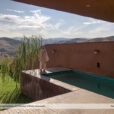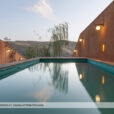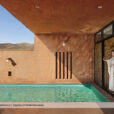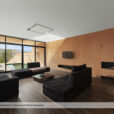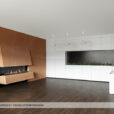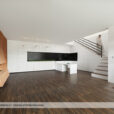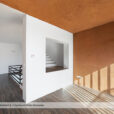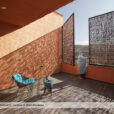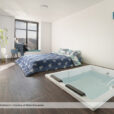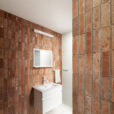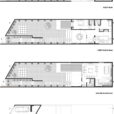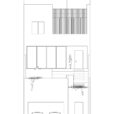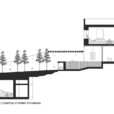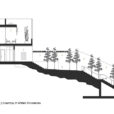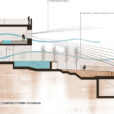ویلای مایان
افشین خسرویان
رتبه دوم پنجمین دوره جایزه شایستگی معمار ایرانی (۱۴۰۱)
موقعیت: روستای مایان، مشهد، ایران
تاریخ: ۱۳۹۸
مساحت: ۲۴۲ مترمربع
وضعیت: ساختهشده
کارفرما: خانواده معمار
تیم طراحی: علی جاوید، فهیمه کریمی، مهسا صداقت
سازه: هومن موحد اول
تاسیسات مکانیکی: مهدی پزشکی راد
تاسیسات الکتریکی: محمدرضا زرینخو
نظارت: وجیهه حسینی ابریشمی
گرافیک: علی جاوید، فاطمه کریمی، سمیه اسعدی
عکس: استودیو نیمکت
ویلای مایان در کناره بیرونی سومین روستای توریستیـییلاقی مشهد (با قدمت ۱۸۰۰ ساله) قرار دارد، در زمینی صخرهای با شیب تند، به مساحت ۲۶۵ مترمربع و عرض ۹ متر که ویژگی خاص آن، چشمانداز بکر و پیوندش با زمینه است. رابطه همساز بین حجم و زمینه، بهگونهای که کمترین تغییر در ریخت تاریخیـطبیعی زمینه صورت پذیرد، مهمترین محور فکری تیم طراحی بود. بر این اساس، مطالعه و شناسایی کامل الگوهای بومی، از ریختشناسی بافت روستای تاریخی تا اکولوژی محیط طبیعی، کمک شایانی به شکلگیری طرح کرد.
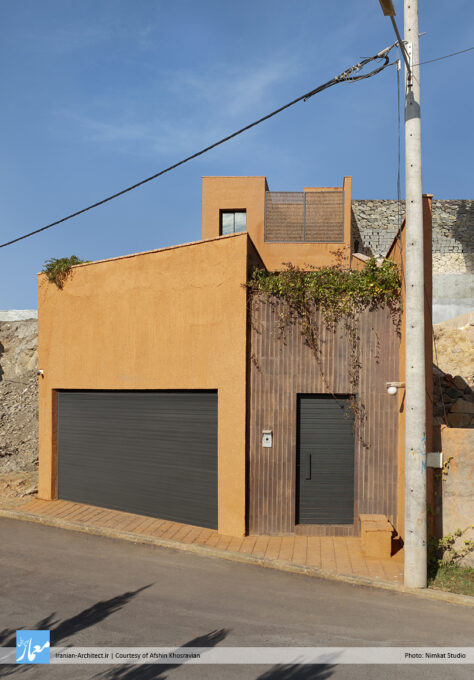
در حوزه نظری طرح، قصد ما بر این بود که الگوی جدیدی برای جلوگیری از نفوذ الگوهای معماری شهری (بهخصوص، از نوع نامطلوب آن) به روستاها پیدا کنیم. تلاش در به چالش کشیدن فرهنگ تجلل در معماری، و ارائه نمونهای از جنس ارزان و آسان که صحبت از کیفیتهای مختلف میکند، از دیگر نیتهای ما در طراحی بود. در نهایت، این پروژه با چالشهای خاصی در همه عرصهها، و با همنشینی دیروز و امروز در اندیشه، فرهنگ، کالبد و حتی جزئیات، شکل گرفت.
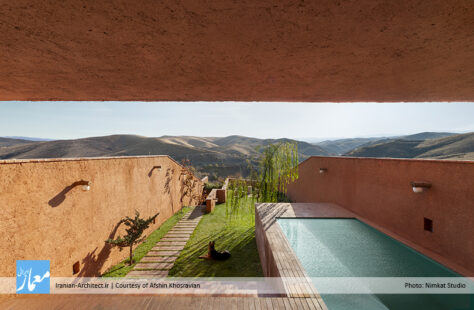
با توجه به محدودیت سطح عرصه، توپوگرافی شدید، و آبوهوای ییلاقی منطقه، طراحی در برش، به عنوان فرایندی برای نحوه شکلگیری رابطه زمینه و حجم، و حل مسائل آن مورد استفاده قرار گرفت. در همین راستا، قراردادن تنها دو حجم (حجم ورودیـپارکینگ و حجم اقامتی) در دو سطح، و برقراری رابطه بین آنها بهوسیله فضای سبز و روفگاردن، به پاسخی متناسب با برنامه، و منظر و عرصه باز پروژه انجامید.
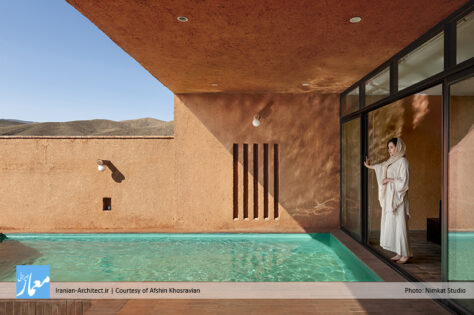
ایوانها نقش کلیدی در کاهش جرم حجم، و تقویت رابطه با زمینه، از طریق تامین دید و نور مناسب بازی میکنند. امتداد حیاط سبز، ایوان نسبتا عمیقی را شکل میدهد که فضای نشیمن مسقف، و همچنین محرمیت نسبی جانبی را برای استخر تعریف میکند. همراهی سایه این فضای مسقف و آب استخر که در مسیر نسیم منطقه (از سوی دره) قرار دارد، ایجاد پدیده دودکشی میکند که با بازکردن پنجره طبقه بام، تاثیر بسیاری در کاهش مصرف انرژی در ایام ییلاق دارد، بهگونهای که مصرف انرژی در فصل تابستان، در طبقه همکف به صفر میرسد. همچنین در حیاط طبقه اول، برای تامین محرمیت مناسب، از یک ساختار باز و بستهشونده با پوشش گیاه بومی منطقه بهنام ارغوان (صنایع دستی منطقه طرقبه مشهد) استفاده شده است.
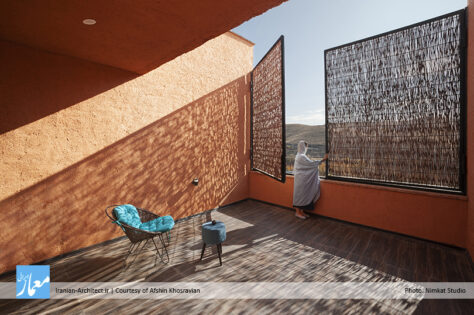
بر اساس الگوی ساخت و متریال طبیعیـتاریخی زمینه، اندود پروژه از کاهگل طبیعی منطقه، همراه با اندکی خاک آهندار و آجر صورت گرفته است که ضمن همسانی با زمینه و القاء حس و حال منطقه، بو و صمیمیتی خاص را همراه با جزئیات ساده چوبی و بومی، به نما اضافه میکند. همچنین استفاده از کاهگل به صورت طبیعی آن (بدون استفاده از تکنولوژی نانو)، و پذیرفتن تعمیرات احتمالی سالانه پروژه، بهرهبرداران را از خواص درمانی جسمی (به گفته قدیمیها، حتی در درمان آلرژی نقش عمدهای دارد) و روحی آن بهرهمند میسازد.
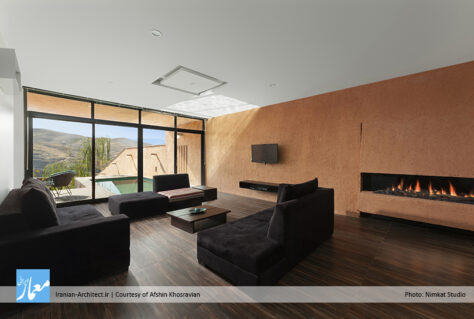
تلاش برای بهکارگیری جزئیات ساده و مصالح بومی، و استفاده از مصالح نوین با صمیمیت و پالایش خاص روستا، یکی از برنامههای طراحی بود. به عنوان مثال، سرویسهای بهداشتی با اندود سیمان ارزان و باکیفیتی کار شدهاند که بوی مطبوع و مطلوبی ایجاد میکند. همه دیوارکوبها و تزئینات نورپردازی نیز با جزئیات بومی و هنرهای دستی منطقه اجرا شدهاند. استفاده از جزئیات آسان، امکان بهکارگیری نیروهای محلی را در مراحل ساخت فراهم میکرد که هم برای کارفرما و هم برای روستا، دارای توجیه اقتصادی بود، و گامی دیگر در تقویت اقتصادی روستاها به شمار میرفت. همچنین استفاده از صنایع دستی ارغوان طرقبه، با توجه به اینکه این گیاه یکی از جاذبههای گردشگری منطقه در فصل بهار است، چشمانداز احیای طرح کاشت دیم این گیاه در منطقه، و اشتغال و درآمدزایی برای روستائیان را در پی خواهد داشت.
Villa Mayan
Afshin Khosravian
2nd Place of Iranian Architect Merit Award 2022
Location: Mayan Village, Mashhad, Iran
Date: 2019
Area: 242 sqm
Status: Completed
Client: The Architect’s Family
Design Team: Ali Javid, Fahimeh Karimi, Mahsa Sedaghat
Structure Consultant: Hooman Movahed Aval
Mechanical Consultant: Mahdi Pezeshki Raad
Electrical Consultant: Mohammadreza Zarrinkhou
Supervision: Vajiheh Hosseini Abrishami
Graphic: Ali Javid, Fatemeh Karimi, Somayeh Asadi
Photo: Nimkat Studio
Villa Mayan is located on the outer side of the third summer tourist village of Mashhad (with a history of 1800 years), in a rocky land with a steep slope, and area of 265 square meters, with a width of 9 meters, which is characterized by a pristine landscape, and its connection with the ground. The most important axis of thought for the design team, was the harmonious relationship between volume and context, so that the least change in the historical-natural form of the background takes place. In this regard, the study and complete identification of native patterns, from the morphology of the texture of the historic village, to the ecology of the natural environment, helped to form the design.
In the theoretical field of the project, we intended to find a new model to prevent the penetration of urban architectural patterns (especially of the undesirable type) to the villages. Trying to challenge the culture of excellence in architecture, and provide an example of cheap and easy material that speaks of different qualities, was one of our other intentions in design. In general, this project was formed with special challenges in all areas, as well as coming together yesterday and today thoughts, culture, body and even details as presented.
Due to the limited area, severe topography, and summer climate of the region, design in section was used as a process to form the relationship between context and volume, and solve its problems. Placing only two volumes (entrance-parking volume, and residential volume) on two levels, and establishing a relationship between them, through green space and roof garden, gave a suitable response to the program, landscape and open area of the project.
Porches play a key role in reducing the mass of the volume, to strengthen the relationship with the ground, by providing adequate visibility and light. The extension of the green courtyard forms a relatively deep porch that defines the covered living space as well as the relative lateral privacy of the pool. The shadow caused by the roofed living space, and the pool water which is located in the direction of the region’s breeze (from the valley), creates a chimney phenomenon, which has a great effect on reducing energy consumption during summer, by opening the roof floor window, in such a manner that energy consumption in the summer, on the ground floor, reaches zero. Also, the yard of the first floor, has been covered with the opening and closing structure of a native plant called Judas-tree (handicrafts of Torqabeh region of Mashhad), to provide proper privacy.
Based on the pattern of construction and natural-historical materials of the background, the building is covered with natural cob, with a little iron soil and brick, that is in harmony with the background, and adds a sense of area, smell, special intimacy with simple wooden and native details. The use of cob naturally (without the use of nanotechnology), and the acceptance of possible annual repairs of the project, will cause the beneficiaries to benefit from the physical and mental healing properties (according to the ancients, it even plays a major role in the treatment of allergies).
Our design plan includes attempting to use simple details and native materials, or to optimize the use of new materials with special intimacy and refinement. For example, sanitary services are made of cheap and quality cement, which creates a pleasant smell. The details of the wall sconces and lighting decorations are all done with local details and handicrafts of the area. The use of easy details made it possible to use local workforce in the construction process of the project, which was economically justified by both the client and the village, and was another step in strengthening the economy of the villages. The use of Judas-tree (Arghavan) handicrafts of Torqabeh, considering that this plant has a special tourist attraction in the region, in spring, will be leaded to the prospect of reviving the rainfed planting plan of this plant in the region, and its development and employment, and income generation for the villagers in a practical way.

